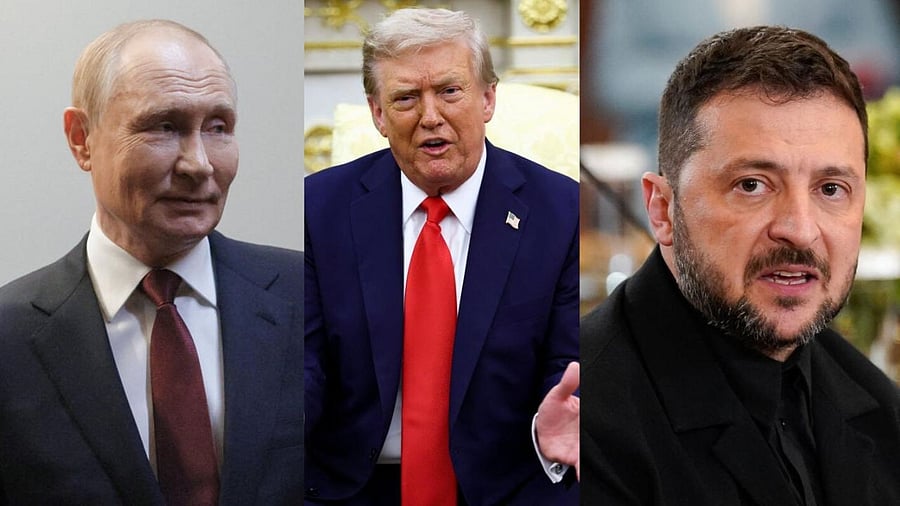
Vladimir Putin, Donald Trump, Volodymyr Zelenskyy
Credit: Reuters Photo
James Horncastle For The Conversation
Burnaby: The current phase of the war in Ukraine continues unabated into its fourth year, with grinding offences and strikes against civilian infrastructure increasingly the norm.
It is, for Ukraine, arguably the most vulnerable that it has been since 2022.
These developments have prompted calls among world leaders to end the conflict. On the surface, United States President Donald Trump’s meetings with both the Ukrainian and Russian leaders suggests a balanced approach. In reality, however, Trump’s actions primarily benefit Russia.
The Alaska summit After the recent meeting with Russian President Vladimir Putin in Alaska, Trump declared that their summit had been “very useful.”
When asked how he would rate the meeting on a scale of one to 10, the president declared the meeting “was a 10 in the sense we got along great.” While Trump and Putin may have hit it off, the issue with such an assessment is that it failed to address the underlying reason for the meeting: Russia’s invasion of Ukraine. In this regard, the meeting was far more useful for Putin and Russia than Ukraine and its allies.
Putin managed to stoke tensions, and potentially divisions, among Ukraine’s principal supporters by not including Ukraine in the summit. No other countries participated in the summit.
This format caused considerable consternation in Ukraine, where it was feared that Trump would make an agreement without Ukrainian consent, as well as in Europe, where Russian aggression and revisionism is a more direct threat.
Prior to Trump assuming power for a second time in 2025, Ukraine benefited from a largely united front among NATO and the European Union. This unity has declined over the last several months, and the Alaska summit reinforced this decline to Russia’s benefit.
Ceasefire demand evaporated Putin and his negotiators managed to obtain a major concession from Trump at the summit as Trump renounced his own recent calls for a ceasefire.
For Ukraine and its allies, achieving a ceasefire was a fundamental requirement for any peace negotiations in 2025. This precondition has become more significant as Russia ramps up its attacks on Ukrainian cities and civilians.
Lastly, the very nature of the Alaska meeting itself helped legitimize Russia in international opinion.
Since its full-scale invasion of Ukraine in 2022, Russia has courted international opinion.
It’s been more successful than most people in Europe and North America realise as significant portions of Asia, Africa and Latin America remain ambivalent or even support Russia in its war against Ukraine.
Nonetheless, Russia was always restrained by the condemnation it’s received from multiple international organisations, most notably the United Nations and the International Criminal Court.
Trump welcoming Putin on American soil, when the Russian leader is under what amounts to a de facto travel ban by the International Criminal Court, undermines these institutions’ condemnations.
Zelenskyy’s visit to Washington The benefits that Putin obtained from Trump in Alaska demanded an immediate response by Ukraine.
President Volodymyr Zelenskyy promptly arranged a White House meeting with Trump in the aftermath of the Alaskan summit. And he didn’t arrive alone: European leaders accompanied him to show solidarity with Ukraine.
Secretary of State Marco Rubio insisted the European leaders weren’t on hand to prevent Trump from bullying Zelenskyy, as occurred during their last Oval Office meeting.
That’s probably only partly true. Several European leaders — ranging from the president of the European Commission, Ursula von der Leyen, to French President Emmanuel Macron — almost assuredly accompanied Zelenskyy to prevent Trump from forcing the Ukrainian leader into concessions that are detrimental to their interests as well.
Trump’s pre-meeting social media post undoubtedly heightened their concerns. In the post, he placed the burden of peace on Zelenskyy and argued that Ukraine must accept the loss of Crimea and never accede to NATO.
Carefully orchestrated Ukrainian officials sought to carefully orchestrate Zelenskyy’s one-on-one Oval Office meeting with Trump. Zelenskyy wore a suit and delivered a letter from the Ukrainian first lady to Melania Trump.
These and other efforts aimed to stroke Trump’s ego, and the president’s response — in particular agreeing with a reporter that Zelenskyy “look(ed) fabulous” in a suit — suggests it was a success. The same American reporter criticised Zelenskyy for failing to don a suit during his ill-fated February White House visit.
Notably, Trump did not rule out a role for American soldiers in helping to maintain peace in Ukraine during the meeting. Outside observers believe an American presence in Ukraine to maintain any eventual peace is a fundamental requirement for its success.
Unfortunately, while Trump did not immediately oppose the idea, he did not make any firm commitment either. Trump’s propensity to reverse course on statements that he makes in the moment, furthermore, undermines any firm takeaways from the meeting.
Hope versus reality Any direct American involvement in Ukraine would also undermine his support among his political base. One of Trump’s key campaign promises was not to involve the US in “endless foreign wars.” A move by Trump to deploy American soldiers to Ukraine would be politically tenuous, as fractures are already emerging among his political base over his handling of the Jeffrey Epstein files.
Trump’s cordial meetings with Zelenskyy and European leaders may fuel hope among Ukraine’s supporters in the coming days. But any optimism should be tempered by the damage done by Trump’s meeting with Putin. Trump reportedly interrupted the meetings in Washington to call Putin.
Trump’s unwillingness to make firm commitments at the meetings with Zelenskyy and European leaders means that Russia, on the balance, has succeeded in advancing its interests to the detriment of Ukraine and the prospects for a long-term, sustainable peace.
The author is Assistant Professor and Edward and Emily McWhinney Professor in International Relations, Simon Fraser University